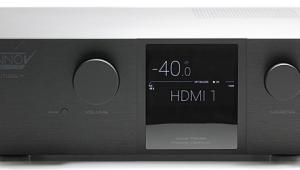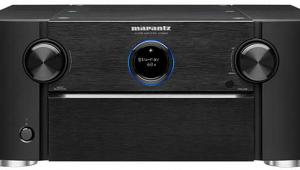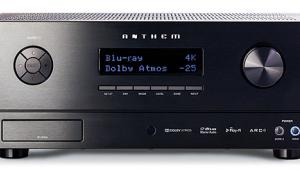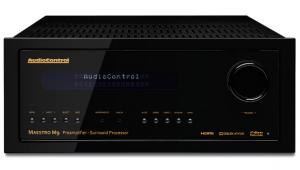Integra DHC-9.9 Surround Processor Page 2

With the DHC-9.9, Integra takes Audyssey even further and incorporates its latest features: Dynamic EQ and Dynamic Volume. Dynamic EQ is an interesting concept, as it deals with psychoacoustics. As many home theater enthusiasts will tell you, louder is almost always better. This is mainly because movie soundtracks are rerecorded on a dubbing stage at a set reference level, and the balance within the mix is determined as the mixers listen at that reference. When you go below that level on playback, definition in the surround channels and bass response can appear to go away. This mainly has to do with your sensitivity to these channels in relation to the rest of the elements. Audyssey compensates for this. As you turn down the volume, Dynamic EQ intelligently changes the surround-channel and bass levels. You’ll still have that perceived level of balance and rich surround environment without having to throttle the volume control way up. I was pretty impressed by how well this feature worked, and I suspect a lot of people will insist on this feature once they experience it. This could also be the feature that finally allows for the cease-fire that so many have prayed for with their significant other when it comes to the volume of the movie. You can turn the overall level down a bit and still have a great, dynamic presentation. I won’t lie, I’m still gonna run my system at levels that would make OSHA shake its head, but at least you have some new options.
Audyssey also rolls Dynamic Volume into this suite of processing. Dynamic Volume incorporates Dynamic EQ, so don’t distress if you want to use both. Dynamic Volume uses different algorithms to control the overall output levels of various sources. You know how cable channels just love to change the volume while you’re watching a show and the commercials come on? Dynamic Volume deals with that issue, but it doesn’t compromise on the balance of elements. This doesn’t just apply to TV viewing; there are plenty of movies that seem to change their volume levels dramatically throughout, as well. Dynamic Volume gives you the option of keeping them more in check. I tried it out with my DVD copies of Lord of the Rings, which seem to get unduly louder in the action sequences compared with the more subtle parts of the films. The difference was noticeable, but at the same time, the dynamics didn’t seem compromised at all. The effect was far more noticeable with TV, and it was a welcome relief from constantly having to change the volume during the commercial breaks.
In Use
The DHC-9.9 reminded me a lot of the previous DTC-9.8 in terms of everyday performance. Setup is intuitive, and Integra provides a simple-to-use onscreen GUI that lets you assign inputs, customize them, and even create your own labels. You can assign each input source to different video and audio inputs. But I was disappointed that you couldn’t assign an HDMI input to more than one source. While this isn’t a huge deal, I would have liked the convenience of sharing HDMI inputs across input sources for my universal player. This would give me the ability to set up one source for high-resolution audio playback and another source strictly for the player’s video playback.
The setup lets you tweak in all of your audio and video parameters, including the ISF tweaks I mentioned earlier. You can also dial in speaker levels, distances, and crossovers. There’s even a full parametric EQ for tweaks. However, I’d recommend that you use this feature with the right measuring equipment.
Another nice touch is default listening modes. For each source, you can select a default playback mode for various input audio signals, including stereo, PCM, and all the Dolby and DTS fla-vors. It includes post-processing modes like THX Cinema, game modes, Dolby Pro Logic IIx, DTS Neo:6, and more. It was great to be able to do this on a per-input basis. I typically don’t apply post-processing enhancements to high-resolution sources like Blu-ray, but I find them compelling with lower-resolution sources like TV and DVD.

The included remote control is identical to the one that accompanies the previous model. It offers full universal remote compatibility, including the ability to learn functions from other IR remotes. The remote is on the large side and is fully backlit. This is a godsend since it has more buttons than just about any remote I’ve seen, and it would be a nightmare to try to navigate them in the dark. The layout is intuitive, but in a room like mine, the breadth of control would be wasted without the backlighting. My only real complaint is its lack of direct access to the different Audyssey modes for on-the-fly changes and comparisons. This would be an invaluable tool for demonstrations and comparisons of the different modes.
The DHC-9.9’s audio performance was every bit as good as the previous DTC-9.8, which earned our Top Pick recommendation. The new Audyssey features make this a nice upgrade from the previous model, and I think the Dynamic EQ function will become very popular among movie lovers. The DHC-9.9 didn’t give up any performance to processors I’ve used in the past with movie playback, but it didn’t have quite the refinement I’ve experienced with analog sources. This was also an issue with the DTC-9.8. When I fed the DHC-9.9 a multichannel analog source, it didn’t give me the detail and resolution I’ve heard from other designs, such as Anthem’s stunning Statement D2 processor. But to be fair, the Anthem costs more than four times as much.
Wrapping It Up
Like the DTC-9.8 before it, the DHC-9.9 gives you unbelievable audio and video performance at a price point you don’t normally see with higher-end processors. Its video processing is second to none. And with full support of every modern audio format and the latest in digital signal processing technologies, it delivers an incredibly rich feature package that actually offers perceivable improvements in performance rather than gimmicky sound modes. If you’re in the market for a feature-rich surround processor, this is one that demands to be experienced no matter what your budget may be.


- Log in or register to post comments





























































